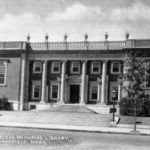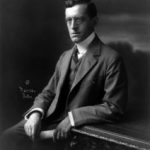Library History
Wakefield's first public library was established in 1856 by a committee consisting of B.F. Tweed, Lilley Eaton, Fred A. Sawyer, J.M. Evans, George O. Carpenter, and James Oliver. The old Town House, overlooking the Common, was its original location. The following year, Town Meeting appropriated $300 to buy books and pay the salary of a librarian. Lucius Beebe was the first chairman of the Board of Library Trustees. The first librarian, from 1856 to 1857, was Henry E. Eaton. He was followed by Miss E.M. Newhall, who served until 1859, by which time the library held 1,678 volumes.
In 1868 the library moved to the new Town Hall, at the corner of Main and Water Streets, which had been donated by Cyrus Wakefield, after whom the town is named. Lucius Beebe donated $500 toward the purchase of new books, which at the time was nearly equal to the annual salary of a typical laborer. That year Town Meeting honored him by voting to change the library’s name to “Beebe Town Library of Wakefield”. Miss Victorine E. Marsh had been appointed librarian in 1868 and she served until 1885 when she resigned due to ill health and was replaced by Mrs. Harriet A. Shepard. In 1904 a branch library headed by Miss H. Gertrude Lee was opened in a room at the Greenwood School.
As the library grew, it became necessary to relocate and expand. In 1916, the townspeople purchased a lot at the corner of Main and Avon Streets for $16,000. That same year, Junius Beebe, son of Lucius Beebe, donated $60,000 (average annual salaries at that time were around $700) toward the construction of a new library building, to be built in memory of his parents, Lucius and Sylenda. The cornerstone was laid on March 17, 1922 and the building was dedicated on April 14, 1923. The architect for the 1922 building was Ralph Adams Cram, of the firm Cram & Ferguson, arguably America’s best Gothic architect, as well as a writer, and art critic for the Boston Transcript. Cram’s most famous works include several buildings at Princeton University, including the chapel, and more than one hundred churches and chapels across the country. He also was the principal architect of the Cathedral of St. John the Divine in New York City and was a consulting architect for the National Cathedral in Washington, D.C. The Beebe Library building was a departure from his usual Gothic work, having been built in a Classical Revival style instead.
The building has a large skylit entrance hall flanked by two reading rooms, each up a short flight of marble stairs. The north reading room is graced by fourteen medallions depicting famous literary figures. Both reading rooms include working marble fireplaces, built-in wooden bookshelves, and elegant Adam style plaster detailing on the walls and ceilings. The central lobby has a black and white marble floor and cast iron stair railings with urn motifs that echo the stone urns on the building’s facade. The beehive, a symbol of the Beebe family, is used throughout the building as a decorative motif, and was chosen in 1998 as the Library’s logo. In 1942 a second branch library was opened in the Montrose school on the northeast side of town. Four years later it was moved to its own building on New Salem Street. For past and current building photos, please visit our Digital Heritage collection.
In 1967 the town appropriated funds to expand the original building, which was becoming overcrowded. An addition was designed by James F. Clapp, Jr., of the Boston architectural firm Shepley, Bulfinch, Richardson, and Abbot. The addition was opened on September 14, 1969. The two branch libraries in Montrose and Greenwood were closed in 1981 due to the effects of mandated budget cuts under Proposition 2 1/2. That same year Wakefield became one of the five founding member towns of the North of Boston Library Exchange, one of the first automated library systems in Massachusetts.
By the late 1980s, Beebe Library had again outgrown its space. New library technologies as well as expanding collections prompted a study into the feasibility of renovating the existing building to provide added space, particularly in the Youth Room, new utility systems, and handicapped accessibility. In November 1995, Wakefield’s Town Meeting approved a $5 million renovation to the Beebe Library, with $3.2 million to be funded by the town and $1.8 million from a construction grant from the Massachusetts Board of Library Commissioners. The challenge was to achieve these goals in the existing structure while retaining the beauty of the historic portion of the building.
The Boston architectural firm of Childs Bertman Tseckares was hired to redesign the building and work with the Library Building Committee and library staff to bring to fruition the goals of the building program, which gutted the 1969 portion of the building and restored the historic 1922 portion. Castagna, Inc. was hired as the general contractor, and the entire project was overseen by the project management firm, the Carlisle Consulting Group. Cheryl Webb Scott, a local interior designer, donated her services to the project to design interiors and select furniture, fabrics, carpets, and color schemes.
Before construction could begin in October 1996, the entire library had to vacate the Main Street site and move to temporary quarters at the Lakeside Office Park. These temporary offices were generously provided at no charge to the town by the Savings Bank of Wakefield for the duration of the construction period. The move took three weeks and the “Library at Lakeside” reopened to the public the second week in October, 1996. Construction on the Main Street building was substantially completed in January 1998, and the library moved back to its beautifully renovated historic building during the month of February. The rededication festivities took place on Sunday, March 15th, 1998, and the next day the library reopened to the public.
Money for furnishings was not part of the project’s funding. At the 1995 Town Meeting, the Board of Library Trustees made a commitment to raise $200,000 through private fundraising. This private money was earmarked to furnish the new building properly and to provide extras not included in construction. The “Furnish Our Future” campaign ultimately raised more than $240,000 from scores of individuals and community groups to purchase comfortable upholstered seating, custom-made computer and study carrels, solid cherry tables, specialty shelving, and custom-designed furnishings for the Youth Room. In addition, many of the library’s original antique furnishings were refinished and reupholstered to be reused in their original settings.
Now over 150 years old, Beebe Library is known not only as an architectural gem of the town, but an active and vital part of the community, serving as an educational and cultural institution and meeting place. Library staff are active in professional and community groups and take pride in Beebe Library’s excellent and innovative public service.
- 1856 – Henry E. Eaton
- 1857 – E. M. Newhall
- 1859 – Emily C. Poland
- 1866 – Ella E. Morrison
- 1868 – Victorine E. Marsh
- 1885 – Harriet A. Shepard
- 1909 – H. Gertrude Lee
- 1925 – Helen F. Carleton
- 1952 – Asbury W. Schley
- 1957 – D. Marjorie Taylor
- 1971 – Ruth B. Litchfield
- 1974 – Margo Trumpeter
- 1978 – Sharon A. Gilley
- 2017 – Catherine E. McDonald
Lucius Beebe
Who was Lucius Beebe?
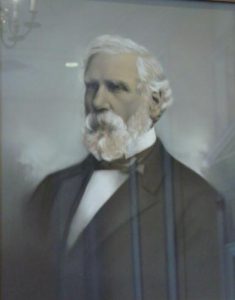 There were actually several Lucius Beebes, but two in particular have important connections to the Beebe Library. The first was born in 1810 in Hebron, Connecticut. After striking out to seek his fortune, he wandered southern New England, eventually apprenticing in a textile factory in Norwich, Connecticut. He learned business skills quickly and in 1834 relocated to New Orleans where he and his brothers became cotton brokers.
There were actually several Lucius Beebes, but two in particular have important connections to the Beebe Library. The first was born in 1810 in Hebron, Connecticut. After striking out to seek his fortune, he wandered southern New England, eventually apprenticing in a textile factory in Norwich, Connecticut. He learned business skills quickly and in 1834 relocated to New Orleans where he and his brothers became cotton brokers.
After marrying Sylenda Morris, a young woman from Wilbraham, Massachusetts, in 1836, he returned to the Boston area and settled first in Cambridge, then in Melrose, and finally in Wakefield (then known as South Reading) overlooking Lake Quannapowitt in an 1810 house built by the Salem architect Samuel McIntyre. The couple had 12 children, one of whom died in infancy. The last four children were born in the house, which was then known as the Beebe Farm.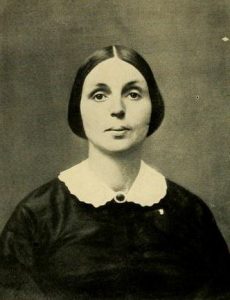
In 1856 Lucius became the first chairman of the town’s new Board of Library Trustees. He also served on Wakefield’s School Committee and Board of Selectmen. In 1868 Lucius made a donation of books for the town’s library, which was then located in Town Hall. The library was later named “Beebe Town Library of Wakefield” in his honor.
Lucius died at his desk in his Boston office in 1884, after which his sons Junius, Marcus, and Decius carried on the family business. Junius eventually became head of the firm. It was Junius who donated $60,000 in 1916 for the construction of a new library building in memory of his parents, Lucius Beebe and Sylenda Morris Beebe. It is this structure, designed by architect Ralph Adams Cram and completed in 1923, which constitutes the front part of the current library building. Each of Lucius and Sylenda’s children generously established trust funds for the purchase of books.
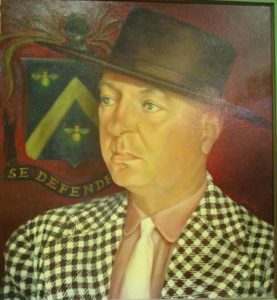 (1902-1966), the other famous Lucius, was the son of Junius Beebe (1854-1934, Lucius and Sylenda’s 9th child) and quite a personality in his own right. He was the last of four children, one of whom died before Lucius was born, and he spent much of his childhood at the Beebe Farm in Wakefield. His youth involved a seemingly continual string of antics, pranks, and altercations and he had the dubious distinction of being asked to leave both Yale and Harvard Universities. He later worked as a journalist for the New York Herald Tribune, where he worked from 1929 to 1950, and the San Francisco Examiner and was a contributing writer to magazines such as the New Yorker, Gourmet, Cosmopolitan, Playboy, Esquire, and Town and Country. A well known bon vivant, Lucius was known for his acerbic wit, extravagant personal style, and gourmet taste and was named one of the ten best-dressed men in America for several years, and appeared on the cover of Life magazine in their January 16, 1939 issue. He wrote over 30 books, many on the topic of railroading, one of his primary interests, as well as witty social commentary. He owned elaborate private railroad cars and traveled the country in them with his literary collaborator and longtime personal companion, Charles Clegg. In 1950 Beebe and Clegg moved to Virginia City, Nevada, near Reno, where they purchased and ran the Territorial Enterprise newspaper for eight years. In 1960 they sold the paper and began dividing their time between Virginia City and Hillsborough, California, a wealthy suburb of San Francisco. Beebe died at the age of 63 of a heart attack at his winter home in Hillsborough on Friday, February 4, 1966. A memorial service was held three days later, on Monday, February 7, at 11:00 a.m. at Emmanuel Church on Newbury Street in Boston. His ashes, reportedly along with those of two of his dogs, were returned to Massachusetts and are buried in Lakeside Cemetery on North Avenue in one of the Beebe family plots, located on “Rainbow Avenue” at the extreme north end of the cemetery. Lucius Morris Beebe was also generous toward the town’s library, continuing the tradition started by his forebears. His brother Junius Oliver (1894-1933) was also active in the library, serving on the board of trustees.
(1902-1966), the other famous Lucius, was the son of Junius Beebe (1854-1934, Lucius and Sylenda’s 9th child) and quite a personality in his own right. He was the last of four children, one of whom died before Lucius was born, and he spent much of his childhood at the Beebe Farm in Wakefield. His youth involved a seemingly continual string of antics, pranks, and altercations and he had the dubious distinction of being asked to leave both Yale and Harvard Universities. He later worked as a journalist for the New York Herald Tribune, where he worked from 1929 to 1950, and the San Francisco Examiner and was a contributing writer to magazines such as the New Yorker, Gourmet, Cosmopolitan, Playboy, Esquire, and Town and Country. A well known bon vivant, Lucius was known for his acerbic wit, extravagant personal style, and gourmet taste and was named one of the ten best-dressed men in America for several years, and appeared on the cover of Life magazine in their January 16, 1939 issue. He wrote over 30 books, many on the topic of railroading, one of his primary interests, as well as witty social commentary. He owned elaborate private railroad cars and traveled the country in them with his literary collaborator and longtime personal companion, Charles Clegg. In 1950 Beebe and Clegg moved to Virginia City, Nevada, near Reno, where they purchased and ran the Territorial Enterprise newspaper for eight years. In 1960 they sold the paper and began dividing their time between Virginia City and Hillsborough, California, a wealthy suburb of San Francisco. Beebe died at the age of 63 of a heart attack at his winter home in Hillsborough on Friday, February 4, 1966. A memorial service was held three days later, on Monday, February 7, at 11:00 a.m. at Emmanuel Church on Newbury Street in Boston. His ashes, reportedly along with those of two of his dogs, were returned to Massachusetts and are buried in Lakeside Cemetery on North Avenue in one of the Beebe family plots, located on “Rainbow Avenue” at the extreme north end of the cemetery. Lucius Morris Beebe was also generous toward the town’s library, continuing the tradition started by his forebears. His brother Junius Oliver (1894-1933) was also active in the library, serving on the board of trustees.
Beebe Family Tree
If you are researching the genealogy of the Beebe family, a good place to start on the web is the Beebe Exchange. A brief version of Lucius’ family tree is given below. For much more detailed information on these branches of the Beebe family, the following title is recommended:
Wilder, Louise Beebe, Lucius Beebe of Wakefield and Sylenda Morris Beebe, his wife, their forebears and descendants, New York : Knickerbocker Press, 1930.
Stuart Beebe (1779-1851) and Sophia Gilbert (?-1855) had the following children:
1. Junius (1809-1850)
2. Lucius (March 2, 1810 – April 15, 1884) – This is the Lucius for whom the Lucius Beebe Memorial Library is named.
3. Marcus (1812-1891)
4. Decius (1814-1900)
5. Cyrus (1817-1843)
Lucius Beebe and Sylenda Morris Beebe married in 1836 and had the following children:
1. Lucius Morris (1837-1886)
2. William (1839 lived only 2 weeks)
3. Charles Stuart (1842-1916)
4. Louisa (1844-1866)
5. Joseph Morris (1846-1857)
6. Cyrus Gilbert (1850-1901)
7. Marcus (1852-1924) twin of Decius
8. Decius (1852-1915) twin of Marcus
9. Junius (October 8, 1854 – 1934) – Junius was the son who donated $60,000 in 1916 for the construction of the Beebe Library in memory of his parents.
10. Frederick (1857-1922)
11. Alice (1860-1929)
12. Sylenda Morris (1863-?)
Junius Beebe and Eleanor Harriet Merrick married in 1886 and had the following children:
1. Junius Merrick (1891-1892)
2. Lucia (1892-?)
3. Junius Oliver (1894-1933)
4. Lucius Morris (December 9, 1902 – February 4, 1966) – This is the Lucius who was famous for his high style, society journalism, and interest in railroading.
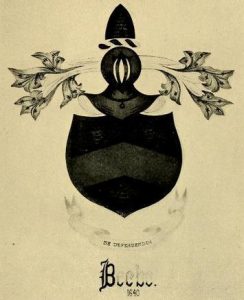 The motto of the Beebe family is “Se Defendendo!” (by defending himself). The family coat of arms consists of a gold chevron (inverted “V” shape) with two gold flying bees above and one below, all on an azure background. The family crest is a beehive. The beehive and bee symbols are found in many places in the Library building, such as in doorframes and on the entrance railings, and are now used as the Library’s logo.
The motto of the Beebe family is “Se Defendendo!” (by defending himself). The family coat of arms consists of a gold chevron (inverted “V” shape) with two gold flying bees above and one below, all on an azure background. The family crest is a beehive. The beehive and bee symbols are found in many places in the Library building, such as in doorframes and on the entrance railings, and are now used as the Library’s logo.
Quiet Reading Room
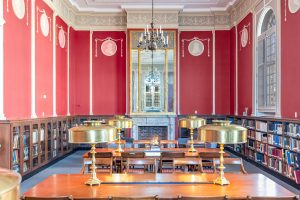 For those who need a quiet place to read or study, the library has a Quiet Reading Room. This elegant room is located in the historic portion of our building on the north side of the main floor and has seating for more than 25 people. In order to maintain the quiet atmosphere, there are no computers or other equipment in this room and we ask that you refrain from any noise or activities that would disturb other researchers. This room also contains our local history and genealogy collections.
For those who need a quiet place to read or study, the library has a Quiet Reading Room. This elegant room is located in the historic portion of our building on the north side of the main floor and has seating for more than 25 people. In order to maintain the quiet atmosphere, there are no computers or other equipment in this room and we ask that you refrain from any noise or activities that would disturb other researchers. This room also contains our local history and genealogy collections.
Considered by many to be the most beautiful room in the Library, the Quiet Study Room is painted a deep red and has abundant plaster detailing in the neoclassical style. The brass reading lamps, as well as the study tables and chairs, are from the original 1922 building and were refinished in the 1997 renovation.
Around the walls are fourteen plaster medallions depicting famous literary figures. There are also two other medallions in the main lobby, one depicting the Argosy and the other the Crusades. These medallions were designed by Benedetto Cippolini of Somerville, Massachusetts. Starting from the right of the fireplace and going around the room, they depict:
- David, the poet of Hebrew literature (d.962 B.C.)
- Homer, the father of epic poetry (9th – 8th cent. B.C.)
- Euripides, the master of tragic poetry (484-406 B.C.)
- Cicero, the Roman orator (106-43 B.C.)
- St. Augustine, the great religious teacher (354-430)
- Geoffrey Chaucer, the father of English poetry (1342-1400)
- Dante, author of the Divine Comedy (1265-1321)
- Desiderius Erasmus, the classical scholar and theologian of the Middle Ages (1466-1536)
- William Shakespeare, the greatest of English poets and dramatists (1564-1616)
- Moliere, the writer of French comedy (1622-1673)
- Goethe, the greatest German poet (1749-1832)
- Ralph Waldo Emerson, American poet and resident of nearby Concord, Mass. (1803-1882)
- Robert Browning, English poet (1812-1889)
- Henrik Ibsen, the great Norwegian playwright (1828-1906)
Dillaway Painting
View our interactive graphic of the History of the Wakefield Library, oil painting by Hope McCloskey Dillaway, 1970.
Art in Building
Read more about paintings, photographs, sculptures and other art on display around the library on the Digital Heritage website. The collection includes photographs and paintings of the Beebe family, as well as paintings by local artists like Tom Morse.

